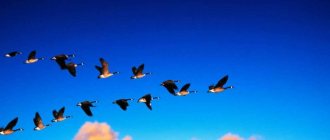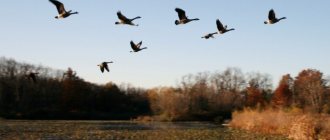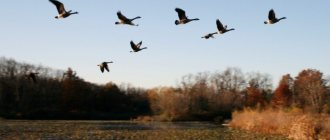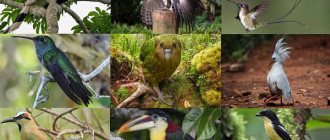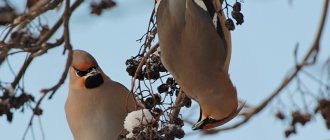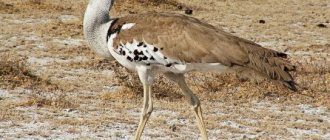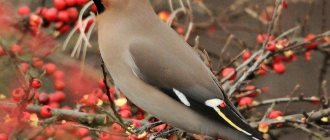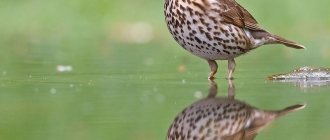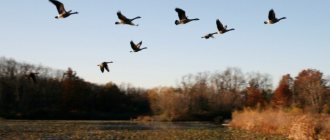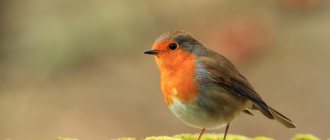Wonderful pictures with migratory and wintering birds. Which birds remain to spend the winter in their homeland, and which ones fly away?
Walking through a park or forest, we listen to birds singing and often simply don’t think about which bird trills so nicely. There are birds that live in our area all year round, but there are also those that fly to “warmer climes” in the fall.
Wild ducks in the sky
The fact is that in winter it is very difficult for birds to find food for themselves, because insects, berries and grains become scarce, and when snow falls, it is almost impossible to find them at all. And different species of birds solve this problem in different ways: migratory birds fly hundreds and even thousands of kilometers to warmer countries, while sedentary birds adapt to our harsh winters.
A tit in the snow, which apparently wants to eat some seeds
Settled, wintering birds: list, photos with names
To help the birds that remain over the winter find food, feeders are hung. And it is quite possible that they will be of interest to the following visitors:
- Sparrow . Noisy sparrows that fly in flocks may well become the first visitors to the feeder.
flock of sparrows
- Tit. Tits are in many ways not inferior to sparrows; they quickly rush to feed in feeders. But compared to sparrows, tits are endowed with a more gentle disposition. Interestingly, in the summer the tit eats almost as much food as it weighs. You can often see mixed flocks of both sparrows and tits at feeders.
Tit with a piece of bread
Sparrows and tit
- Gaichka . A close relative of the tit. However, the chickadee's breast is not yellow, but light brown. The chickadee also differs from other tits in that it makes a hollow in a tree to make a nest in it.
The chickadee is a special type of tit
- Crow. Ravens are often confused with rooks. It is known that in the western part of Russia crows are very rare. Therefore, if you live in the European part of Russia and see a black bird emitting a piercing croak, then most likely it is a rook.
Black Crow
- Pigeon. The distribution and lifestyle of pigeons was largely influenced by people who simply brought them with them to different parts of the Earth. Now pigeons are found on all continents except Antarctica. Pigeons easily exchange rocks, which are their natural habitat, for man-made structures.
The nodding gait of pigeons is due to the fact that this makes it easier for them to examine the object of interest to them.
- Woodpecker. In the warm season, woodpeckers feed mainly on insects, which they get from under the bark of trees, and in the cold winter, they can also feed on plant foods: seeds and nuts.
Woodpeckers love to eat seeds from pine and spruce cones.
- Magpie. The magpie is considered a bird of high intelligence; it is capable of expressing a lot of emotions, including sadness, and can recognize its reflection in the mirror. It is interesting that not only its fellow birds react to the alarming cry of a magpie, but also other birds, as well as wild animals, in particular bears and wolves.
Magpie - wintering bird
- Owl . Owls come in different varieties, large and small, and there are more than 200 species in total. These birds are endowed with acute vision and excellent hearing, which allows them to lead a nocturnal lifestyle. It is interesting that the tufts on the owl's head are not ears, the real ears of owls are hidden in the feathers, and one of them is directed upward, and the other downwards, in order to better hear what is happening above the head and on the ground.
Owl is a night bird
- Owl. This bird is also considered an owl and is a close relative of other owls.
Owl
- Tawny owl. A rare owl that lives mainly in mountainous areas in northern latitudes. The name of the bird, according to different versions, means “inedible” or “insatiable.”
Tawny Owl
- Jackdaw. Externally, jackdaws are similar to rooks and crows; moreover, there are mixed flocks in which all three species of birds can be seen. However, the jackdaw is smaller in size than the crow. And if you are lucky enough to observe a jackdaw up close, you can easily recognize it by the gray color of some of its feathers.
Jackdaws really like shiny objects
- Nuthatch. This little bird climbs tree trunks very deftly. In summer, nuthatches hide seeds and nuts in the bark, and in winter they feed on these supplies.
Nuthatch on a birch tree
- Crossbill. Like the nuthatch, this bird is excellent at climbing trees and can hang upside down on branches. Crossbill's favorite food is seeds from spruce and pine cones. This bird is remarkable in that it can hatch chicks even in winter, but only if there is enough food.
Crossbill on spruce branches
- Bullfinch. Only males have bright red plumage on the chest; females look much more modest. Bullfinches are more often seen in winter, because due to lack of food, they are drawn to people. In summer, bullfinches prefer wooded areas and behave inconspicuously, so they are not easy to see.
Pair of bullfinches
- Waxwing . A bird with beautiful plumage and a singing voice. In summer it feeds mainly on insects and likes to settle in coniferous forests. In winter, the waxwing moves to more southern regions of the country and is often found in cities. In the cold season, rowan and other fruits become the main food for birds.
Waxwing on a rowan branch in winter
- Jay. A large bird, which, however, can fly to feast on a feeder hung by people. In the summer it is rarely seen in the city, but closer to winter the bird begins to reach out to human habitation.
Jay in winter
- Kinglet. One of the smallest birds, the weight of an adult male is only 5-7 grams. Kinglets are relatives of sparrows.
Kinglet - forest dweller
- Pheasant . A large bird that is a favorite trophy for many hunters. Pheasants can fly, but most often move on foot.
Pheasant
- Hazel grouse . It is also an object of hunting, despite the fact that this bird is quite small. The weight of an adult hazel grouse rarely reaches 500 g. Interestingly, the largest population of these birds lives in Russia.
The hazel grouse is a bird that is related to the black grouse
- Black grouse. Another bird that is related to hunting. Black grouse are found at the edge of the forest and in the forest-steppe.
Grouse
- Sokol . It is considered one of the smartest birds on the planet and one of the best hunters. The falcon is capable of working in tandem with a person, but it is very difficult to tame it.
Falcon in flight
- Hawk . Like the falcon, it is a bird of prey. A hawk's vision is 8 times sharper than a human's. And rushing after prey, the hawk can reach speeds of up to 240 km/h.
Hawk
What animals mate for life?
10 Animals That Mate for Life
- Gibbons Gibbons are humans' closest relatives and mate for life. ...
- Black Vultures Looking good is not a requirement for a committed relationship. ...
- Wolves...
- Termites...
- Common turtle doves
13 Apr
2011 Interesting materials:
How to strip a thick wire? How to set an angle in AutoCAD? How to upload photos from gallery to the cloud? How to upload a photo to Wildberry? How to upload GIF to Instagram from iPhone? How to upload a disk to Yandex and send a link? How to upload multiple photos to Instagram from PC? How to upload full video to Facebook? How to upload your background to open office? How to upload your font to Handwritten?
Migratory and nomadic birds: list, photos with names
- Rook. Rooks differ from crows in having a gray-yellow beak. In Kuban and Ukraine, you can see how in the fall rooks gather in huge flocks, so large that the sky seems black from the birds soaring in it - these are rooks that fly south. However, rooks are classified as migratory birds only conditionally, some of them remain to winter in central Russia, some winter in Ukraine, and only some birds fly to the warm shores of Turkey for the winter.
The sky in which rooks circle
- Rooks love to fly to freshly dug ground; sometimes they fly right behind a plowing tractor in order to have time to get as many worms and larvae as possible from the dug up ground.
Rook
- Nightingale. This inconspicuous bird with a singing voice loves warmth, and therefore flies south in the fall. And for wintering, our native nightingales chose hot Africa. These birds fly to the eastern part of the continent - Kenya and Ethiopia - for the winter. However, local residents cannot enjoy their singing, because nightingales sing only during the mating season, which takes place in their homeland.
Nightingale
- Martin. Swallows love rocky terrain; they often settle on the steep walls of quarries that people have dug. However, our winters are too harsh for swallows and therefore in the fall they fly to the southern part of Africa, far from us, or to Tropical Asia.
Swallow in flight
- Chizh . Like the rook, it is a migratory bird that arrives early and winters nearby: in the Caucasus, Kazakhstan and southern Europe. Externally, siskins are inconspicuous, their gray-green feathers are absolutely not noticeable against the background of the branches. The bird's temperament matches its appearance: quiet and meek.
Gray-green plumage of a siskin
- Goldfinch. In Europe it is a wintering bird, however, in Russia goldfinches can only be seen in summer. By winter, goldfinches gather in flocks and move to lands with a warmer climate. Goldfinches are close relatives of siskins.
The goldfinch is one of the most colorful birds
- Wagtail. A slender bird that runs quickly along the ground and shakes its tail with every step. Wagtails spend the winter in eastern Africa, southern Asia, and sometimes southern Europe.
Wagtail
- Quail. The only bird from the Galliformes order that is migratory. The weight of an adult quail is not so large and amounts to 80-150 g. In summer, quails can be found in fields sown with wheat and rye. Quails winter far beyond the borders of our homeland: in southern Africa and southern Asia, on the Hindustan Peninsula.
Quail in the grass
- Drozd . The song thrush, with its sweet trills, creates worthy competition for the nightingale. And his appearance, like that of the nightingale, is inconspicuous. In winter, blackbirds become Europeans: Italy, France and Spain are their second homeland.
song thrush
- Lark . Larks return from warm countries very early; sometimes already in March you can hear their sonorous song, which becomes a harbinger of spring warmth. And larks spend the winter in Southern Europe.
Lark in spring
- Seagull . With the onset of cold weather, seagulls living on the coasts of the northern seas migrate to the Black and Caspian Seas. But over the years, seagulls are increasingly drawn to people, and increasingly remain to spend the winter in cities.
Seagull on the warm coast
- Swift . Swifts winter in Africa, and fly to its equatorial part or even go to the southern part of the continent.
Swift
- Starling. Starlings really need birdhouses, since most often they breed their offspring in them. And our starlings go to Southern Europe and East Africa for the winter.
Starling
This bizarre black cloud is a flock of starlings returning home
- Chaffinch . Finches from the western part of the country winter mainly in Central Europe and the Mediterranean, and finches that live near the Urals in the summer go to winter in Southern Kazakhstan and the southern regions of Asia.
Chaffinch - a noisy inhabitant of the forest
- Heron . It is quite difficult to determine where herons spend the winter; some of them travel huge distances to South Africa, some winter in the Crimea or the Kuban, and in the Stavropol Territory, herons sometimes even remain for the winter.
Heron in a pond
- Crane . These birds are monogamous, and once having chosen a partner, they remain faithful to him throughout their lives. Cranes settle in swampy areas. And their wintering places are as diverse as those of herons: Southern Europe, Africa and even China - in all these parts of the world you can find cranes that have flown from Russia to spend the winter.
Cranes
- Stork . In Russia there are black and white storks. White storks build huge nests, up to one and a half meters wide, and make very long flights to the south. Sometimes they cross half the planet and reach South Africa, a country located in the very south of Africa.
Storks nest
- Swan . The swan is a bird that represents devotion and romance. Swans are waterfowl, so for wintering they choose places near water, often the Caspian or Mediterranean Sea.
Swan mother and her babies
- Duck . Wild ducks, as a rule, do not fly far in winter and remain in the vast expanses of post-Soviet states. It is noteworthy that their domestic relatives also begin to worry in the fall and sometimes try to fly away, sometimes they even fly over fences and fly short distances.
wild ducks
- Cuckoo . Cuckoos live in forests, forest-steppe, and steppe. The vast majority of cuckoos fly to tropical and South Africa for the winter; less commonly, cuckoos winter in South Asia: India and China.
Cuckoo
- Oriole . A small bird with a singing voice and bright plumage that flies to the tropics for the winter.
Oriole
- Robin . They wake up at dawn and are among the first to start the morning song. This little songbird used to be called a robin. Robins fly to Southern Europe, North Africa and the Middle East to spend the winter and are among the first to return home.
Robin
Distinctive features
In terms of external characteristics, migratory birds do not differ from domestic (sedentary) birds. Neither their plumage, nor the type of wings or the structure of their head will tell you this. The only exceptions are flightless and domesticated birds (chickens, domestic ducks, turkeys).
Traveling individuals differ in the type of food they eat and their sensitivity to reduced daylight hours. Feeling the discomfort associated with negative changes in these factors, the birds form flocks and go to the continent where the opposite trend occurs at this time of year.
These birds are also distinguished by the ability to accurately navigate in space and endurance during long periods of flight. For example, sparrows, well-known sedentary birds, cannot stay in the air for more than 15 minutes. As for travelers, they are not afraid of exhausting flights that last for days.
What is the difference between migratory birds and wintering birds: presentation for preschoolers
Wintering and migratory birds: presentation for preschoolers
Slide 2
Slide 3: presentation of migratory birds
Slide 4
Slide 5
Slide 6
Slide 7
Slide 8: presentation of wintering birds
Slide 9
Slide 10
Slide 11
Slide 12
Crossbill
Many people are interested in the question: is crossbill migratory? No, this is a nomadic species , as evidenced by the following signs:
- he makes movements not related to seasonality, but in search of food,
- migrations do not occur along a specific route, but in a chaotic manner;
- The nesting area directly depends on the amount of food: seeds of pine, spruce, larch.
Cedar trees, waxwings, and bee-eaters behave in a similar way, so they are also nomadic representatives of the feathered world.
Why do migratory birds fly to warmer regions where they spend the winter, and why do they come back?
Winter is a harsh test for birds. And only those who can get food for themselves in harsh conditions remain to spend the winter.
Bullfinch getting seeds
What could be the ways for birds to survive in the cold season?
- Some birds store food for the winter in the summer. They hide plant seeds, nuts, acorns, caterpillars and larvae in grass and cracks in tree bark. Such birds include the nuthatch.
- Some birds are not afraid of people and live near residential buildings. In winter, they find food in feeders and garbage heaps.
- Some birds are predators and feed on rodents. There are birds of prey that can feed on hares, hunt fish, small birds and bats.
Rowan saves many birds from hunger in winter.
If a bird can find food for itself in winter, it means it does not need to go on a tedious and difficult flight to warmer climes in the fall.
Bullfinches peck bread crumbs in a feeder
It would seem that everything is simple, and the only reason for the seasonal migration of birds is the lack of food. But in reality there are more questions here than answers. For example, imagine that a wild duck, which is a migratory bird, is provided with an artificially heated pond and a sufficient amount of food. Will she stay for the winter? Of course not. She will be called on a long journey by a strong feeling that is difficult to explain, called natural instinct.
Wild ducks in the sky
It turns out that birds fly to warmer regions, as if out of habit, because their ancestors did this for hundreds and thousands of years.
Chicks
Another question that requires an answer: why do birds return from warm countries every spring? Ornithological scientists have concluded that the beginning of the return flight is associated with the activation of sex hormones and the beginning of the breeding season. But why do birds fly thousands of kilometers and hatch their chicks exactly where they were born? Poets and romantic people say that birds, like people, are simply drawn to their homeland.
How do migratory birds know where to fly? A question to which to this day there is no clear answer. It has been experimentally proven that birds can navigate in completely unfamiliar terrain and in conditions of limited visibility, when neither the sun nor the stars are visible. They have an organ that allows them to navigate the Earth's magnetic field.
But the mystery remains how young individuals, who have never flown to warm regions before, find their own wintering place, and how do they know the route to fly? It turns out that in birds, at the genetic level, information about the point on the map where you need to fly is recorded and, moreover, a route to it is drawn.
Birds unerringly find their way to their wintering grounds
Traveling tribes
Migratory birds live in two countries. They are forced to do this by searching for a comfortable place to winter. Depending on the species, birds migrate at different times. So, before anyone else, namely in August, nightingales, swifts, and orioles leave their homeland. Waterfowl (ducks and swans) fly away only after the first frost.
The complete list of names of migratory birds whose homeland is our country is very wide.
Among them are urban:
- swallows,
- nightingales,
- swifts,
- wagtails,
- larks,
- robins.
Forest:
- swans,
- wild ducks,
- flycatchers,
- herons,
- finches,
- orioles,
- lapwings,
- fieldfare and others.
It is noteworthy that during the wintering all traveling birds wait to return home without creating families. And only in their homeland do they form pairs and have offspring.
Which birds are the first and last to arrive in spring?
The rooks are the first to arrive in the spring . These birds return to their homeland in early spring, when the first thawed patches in the snow appear. With their strong beaks, rooks dig out larvae in such thawed areas, which form the basis of their diet.
The last to arrive are the birds, which feed on flying insects. These are swallows, swifts, and orioles. The diet of these birds consists of:
- Komarov
- Much
- Moshek
- Horseflies
- Zhukov
- Cicadas
- Butterflies
Since the emergence of a large number of adult flying insects from larvae requires warm weather and about two weeks of time, the birds that feed on them fly to their homeland after the mass appearance of these insects.
Geese are preparing to fly to warmer climes
Basic principles of the flight
Many people are interested in how birds navigate during a long journey and how their internal navigator works. Interaction with the northern magnetic field of our planet helps them in this. It points the birds to their homeland and helps them accurately determine their location on one or another part of their journey.
There are two types of flight: active (flapping) in swifts and swallows. And passive (soaring) in swans and storks.
Flocks are formed according to a number of principles developed at the genetic level.
The strategic flight characteristics of different bird species differ depending on the size of the individuals, their weight and body structure. In particular, small birds (starling or quail) develop about 90% of their total speed from the first seconds of flight. Large birds increase their speed by getting into the right wind currents.
What flock of migratory birds promises snow?
geese has flown south , you should expect the first snow to fall. This sign may not coincide with real weather phenomena. So in the north of Russia, geese fly to warmer climes in mid-September, and snow can fall much earlier. Let's say the first snow in Norilsk this year fell on August 25th. In the south, geese fly to warmer climes at the end of October, and sometimes even at the beginning of November. The first snow in these areas may occur around this time. But it all depends on the weather conditions in autumn. Indian summer here can last throughout October.
VIDEO: Geese gather in flocks to fly south
Nightingale
Even a child knows about this amazing creature. He is popularly known for his magnificent singing abilities and amazing appearance.
For many years , ornithologists did not know why the nightingale makes such beautiful sounds and sings most of its life. As a result of long research, it was possible to determine that when singing, the bird does not pay attention to the dangers that surround it. She humbly lowers her wings and continues to receive incredible pleasure from her favorite activity. It would be great if people treated art the same way.
With the arrival of winter cold weather, the nightingale moves to North Africa, but returns home in mid-April. Already during this period one can hear the first delightful songs of this tiny creature. As soon as insects are born, the bird’s life takes on new vigor.
Which bird from the order Galliformes is migratory?
A migratory bird from the order Galliformes is the quail . The quail's habitat extends beyond Russia in the west and south. In the east, these birds live up to the western coast of Lake Baikal. They are widespread in Europe, Western Asia and Africa.
Quail habitat
For the winter they fly south. And they winter in Hindustan, Northern Africa and South-West Asia.
Swallows are brave travelers
Birds are forced to leave their nests due to lack of food, since they feed exclusively on insects.
These birds, despite their modest size and apparent fragility, are very hardy and strong.
It is worth noting that the physical structure of the swallow has an impeccable shape, which is created for flight: a streamlined body, a long forked tail, pointed wings and good navigation. In addition, birds quickly get used to weather changes and adapt to its conditions.
They make their flights to warm countries twice a year, each time covering enormous distances. This process involves a lot of risk. Many individuals, never reaching their destination, die from exhaustion, hunger and temperature changes. Under unfavorable weather conditions, entire flocks of these migratory birds sometimes die. There is even more information in the article “Swallow Bird: Country, City and Others.”
Owl
The eagle owl is the largest bird among the owls, its height is 0.6–0.8 m, its wingspan is up to 1.9 m. It is distributed throughout Eurasia, except the far north. Hunts by planning. It is a wintering sedentary species.
The plumage is motley, brown tones, loose, absorbs the sounds of flight. There are feathers sticking out on the head, like “ears”. The paws are completely covered with feathers, the claws are large. Amber eyes stand out on the facial disc. During courtship, partners call each other loudly, forming permanent pairs.
Thanks to the special structure of the spine, the eagle owl's head can even turn backwards.
Hunts in the evening all night. It feeds on rodents, hares, birds, frogs, and fish.
Nests are located on the ground, in the roots of trees, among brushwood. The female incubates, the male feeds her and the chicks. The chicks are covered with down and blind. At 2 months they begin to fly, at 3–4 months they leave their parents.
Rice. 3. Eagle owl.
Owl
This wise bird leads a sedentary lifestyle without migrating. In cold weather, there is enough food for the owl in the forest, so it can easily cope with the difficulties of wintering. Due to the fact that this predator has tenacious claws , the owl can catch small rodents, which are most often in its diet in cold weather.
The world of migratory birds is very rich and diverse, many of them lead a completely unique lifestyle. However, sedentary birds are also of interest due to how they manage to adapt to unfavorable conditions and survive in a hungry winter. All that remains is to admire the logic and thoughtfulness of nature!
Summer
Bird life in summer
The main task of each species of birds for the summer is feeding and adapting the chicks to life. If the summer turns out to be rainy and cool, then the life of birds becomes somewhat more difficult. Chicks die from colds and hunger. And the parents themselves are in great danger while it rains.
Drought is also not a favorable state of nature for birds. For birds living in swamps, drought is a disaster. During such periods, wading birds are forced to go out in search of a new habitat. And if the hot days drag on, the vegetation begins to dry out. This situation is dangerous for all types of birds.
The main task of birds for the summer is to teach their chicks to fly, so that in the fall they can fly south with their parents.
As a rule, summer days are accompanied by early dawn and late sunset, so the days of many birds become longer. So, for example, chickadees, they wake up with the first rays of the sun and fall asleep at sunset.
And the songs of the redstart can be heard at any time of the day, because they wake up before sunrise and fall asleep at dusk.
In the summer, birds are especially active and lead their usual lifestyle. Day and night predators hunt in forests and steppes. The familiar inhabitants of crowded places fly along the streets of cities and villages.
